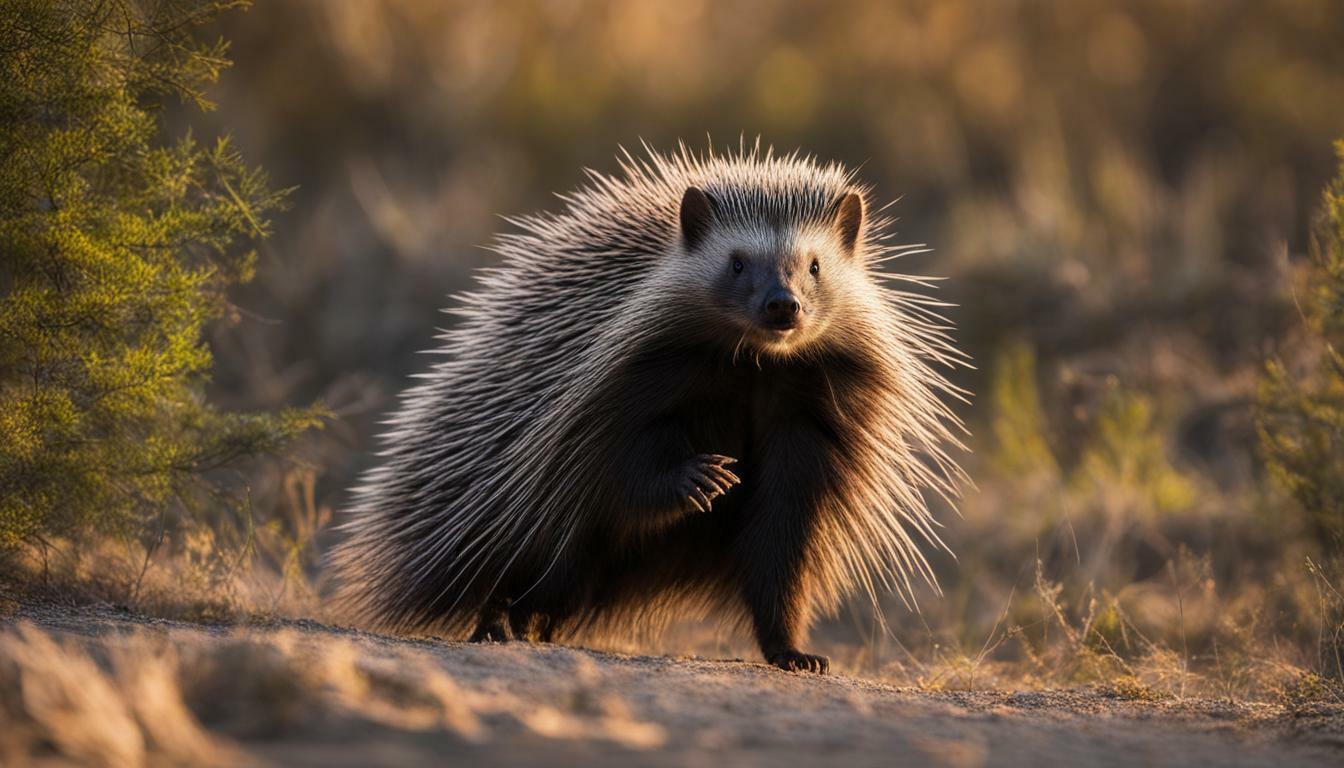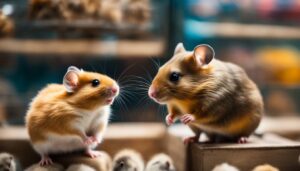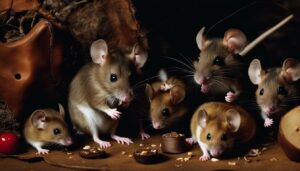Discover the fascinating defense mechanisms and protection strategies employed by porcupines to ward off potential threats.
Porcupines defend themselves using their sharp quills. When threatened, a porcupine will raise its quills, making itself appear larger and more intimidating. It may also swing its quilled tail towards the threat. The quills have sharp tips and barbs, making them difficult to remove once they are stuck in an attacker’s skin. Contrary to popular belief, porcupines cannot shoot their quills, but the quills do detach easily when touched. Porcupines grow new quills to replace the ones they lose. Porcupines also have the ability to release their quills after they have penetrated the skin of an enemy, causing tremendous pain and distracting the attacker. Some predators, like fishers, wolverines, and coyotes, may prey on porcupines, but they have to be cautious to avoid getting quilled. Porcupines are primarily herbivorous, feeding on twigs, roots, stems, berries, and tree bark. Porcupines can be found in various habitats, including forests, deserts, and grasslands. They are also known to invade human settlements in search of salt, sometimes causing damage to objects coated in salty sweat. Overall, the porcupine’s quills are its most effective defense mechanism.
Key Takeaways:
- Porcupines defend themselves with their sharp quills, which they can raise and swing towards threats.
- Quills have sharp tips and barbs, making them difficult to remove and causing pain to attackers.
- Porcupines cannot shoot their quills, but they can detach them easily when touched.
- Porcupines grow new quills to replace the ones they lose.
- Predators like fishers, wolverines, and coyotes need to be cautious to avoid getting quilled when hunting porcupines.
Porcupine Anatomy and Defense Tactics
Porcupines possess unique anatomy and employ specialized defense techniques to deter predators and ensure their safety. One of the most distinctive features of a porcupine is its quills. These quills, which are actually modified hairs, cover the porcupine’s body and act as a formidable defense mechanism.
When threatened, a porcupine will raise its quills, making itself appear larger and more intimidating. It may also swing its quilled tail towards the threat. The porcupine’s quills have sharp tips and barbs, making them difficult to remove once they are stuck in an attacker’s skin. Contrary to popular belief, porcupines cannot shoot their quills, but the quills do detach easily when touched.
Porcupines grow new quills to replace the ones they lose, ensuring they always have a sufficient defense. They can also release their quills after they have penetrated the skin of an enemy, causing tremendous pain and distracting the attacker. This defense mechanism not only inflicts physical discomfort but also buys the porcupine valuable time to escape from danger.
Some predators, such as fishers, wolverines, and coyotes, may prey on porcupines, but they have to be cautious to avoid getting quilled. The porcupine’s quills act as a powerful deterrent, effectively discouraging most predators from pursuing them as prey. Porcupines are primarily herbivorous animals, feeding on twigs, roots, stems, berries, and tree bark. They can be found in various habitats, including forests, deserts, and grasslands. However, porcupines are also known to invade human settlements in search of salt, sometimes causing damage to objects coated in salty sweat.
| Porcupine Anatomy and Defense Tactics | |
|---|---|
| Unique Anatomy | Specialized Defense Techniques |
| – Quills covering the body | – Raising quills to appear larger and more intimidating |
| – Sharp tips and barbs on quills | – Swinging quilled tail towards threats |
| – Quills detach easily when touched | – Releasing quills after penetrating enemy’s skin |
| – Continuous quill regeneration | – Causing pain and distraction to attackers |
| – Deterrence against predators | |
| – Herbivorous diet | |
| – Variety of habitats | |
| – Potential intrusion into human settlements |
The Role of Quills in Porcupine Defense
The sharp quills of a porcupine play a crucial role in its defense against potential threats. When faced with danger, a porcupine will raise its quills, making itself appear larger and more intimidating. These quills, which are modified hairs, cover the porcupine’s body, providing a formidable defense mechanism.
Porcupines also employ a technique known as quill display to deter predators. When threatened, they will turn their backs to the danger, exposing the quills and making it clear that they are armed and ready to defend themselves. This warning display is often enough to dissuade predators from approaching.
The quills themselves are incredibly effective at deterring attackers. Each quill has a sharp tip and tiny backward-facing barbs, which make them difficult to remove once embedded in an attacker’s skin. Contrary to popular belief, porcupines cannot shoot their quills, but the quills are easily detached when touched. This not only inflicts pain on the predator but also serves as a distraction, allowing the porcupine to escape to safety.
The Detachment and Regeneration Process of Quills
When a porcupine loses quills during a defensive encounter, it will grow new ones to replace them. Quill regeneration is a fascinating process that ensures the porcupine remains equipped with its potent defense mechanism. The new quills grow from the same follicles as the old ones, gradually replacing them over time. This continuous renewal allows the porcupine to maintain its protective armor.
| Porcupine Defense Techniques | Porcupine Quill Characteristics |
|---|---|
| Quill display | Sharp tips |
| Tail swinging | Backward-facing barbs |
| Quill detachment | Growth from same follicles |
It is important to note that while quills are the primary defense mechanism of porcupines, they are herbivorous creatures that primarily feed on twigs, roots, stems, berries, and tree bark. Porcupines can be found in various habitats, including forests, deserts, and grasslands. However, they may also venture into human settlements in search of salt, which can sometimes lead to damage to objects that are coated in salty sweat.
In summary, the porcupine’s quills are highly effective in deterring potential threats. Their sharpness, barbs, and ability to detach make them a formidable defense mechanism. By understanding the role and characteristics of these quills, we gain insight into how porcupines have evolved to protect themselves in their natural habitats.
Quill Display and Intimidation
When faced with danger, porcupines employ intimidating displays by raising their quills, effectively warding off potential attackers. These quills, which are modified hairs, serve as the porcupine’s primary defense mechanism. The porcupine raises its quills by contracting tiny muscles surrounding each hair follicle, causing them to stand upright and making the porcupine appear larger and more threatening to predators.
Porcupines also utilize their quilled tail as a warning signal. When feeling threatened, they swing their tail towards the source of danger, allowing the sharp quills to serve as a visual deterrent. The sight of an erect and quivering porcupine, with its quills on full display, is often enough for many predators to think twice before launching an attack.
The quills themselves are highly sophisticated structures that enhance the porcupine’s defense. Each quill is equipped with sharp tips and tiny backward-facing barbs that make them difficult to remove once embedded in the attacker’s skin. Although porcupines cannot actually shoot their quills, they can easily detach them upon contact, which leaves the attacker to deal with a painful reminder of their failed attempt.
| Predator | Precautions to Avoid Quills |
|---|---|
| Fisher | Approach cautiously from behind to avoid the spiky tail. |
| Wolverine | Attack vulnerable areas, such as the stomach, to minimize contact with quills. |
| Coyote | Use quick and precise strikes, aiming for areas without quills, like the face or legs. |
Overall, porcupines rely on their impressive quills and intimidating displays to defend themselves against potential threats. The quills’ ability to cause pain, the difficulty of their removal, and the warning signals displayed by the porcupine all contribute to their effectiveness as a defense mechanism. These remarkable adaptations allow porcupines to navigate their environments with confidence, ensuring their survival even in the presence of formidable predators.
Quill Detachment and Pain Infliction
Porcupines possess the ability to release their quills, causing intense pain and serving as a powerful deterrent against predators. When confronted with a threat, the porcupine will arch its back, making the quills stand erect and imposing. It may also swing its quilled tail towards the attacker, aiming to strike and embed its sharp spines into the predator’s skin.
The quills of a porcupine are covered in tiny barbs, which make removal difficult once they are lodged in an enemy’s flesh. While a common misconception suggests that porcupines actively shoot their quills, in reality, the quills detach easily upon contact. This remarkable defense mechanism allows the porcupine to escape from the predator while inflicting significant pain and discomfort.
After the quills have penetrated the attacker’s skin, they continue to cause distress. The barbs on the quills make the removal process excruciating, often requiring medical assistance. The pain inflicted by the porcupine’s quills serves as a powerful deterrent, discouraging potential predators from engaging in future attacks.
It is important to note that the porcupine’s quills are not poisonous, but their ability to cause pain and discomfort makes them an effective defense strategy. By using quill detachment and pain infliction, the porcupine ensures its safety in the face of danger and proves that its unique defensive adaptation is a force to be reckoned with.
Quill Detachment and Pain Infliction: A Summary
- Porcupines can release their quills, causing intense pain and serving as a powerful deterrent against predators.
- Quills have tiny barbs, making them difficult to remove once they are stuck in an attacker’s skin.
- Porcupines cannot shoot their quills, but the quills do detach easily upon contact.
- The quills continue to cause pain and discomfort, often requiring medical assistance for removal.
- Porcupine’s quills are not poisonous, but their ability to cause pain and discomfort makes them an effective defense mechanism.
| Quill Detachment and Pain Infliction: Key Points | |
|---|---|
| Ability to Release Quills | Porcupines possess the unique ability to release their quills when touched or embedded in an attacker’s skin. |
| Pain and Discomfort | The quills cause intense pain and discomfort, making them an effective deterrent against predators. |
| Difficulty of Removal | The tiny barbs on the quills make them difficult to remove, often requiring medical assistance. |
| Non-Poisonous Defense | The quills are not poisonous, but their pain-inflicting properties serve as a powerful defense strategy. |
Predators and Porcupine Defense
Despite their formidable defenses, porcupines encounter predators who have learned to adapt their hunting strategies when targeting these spiky creatures. Some predators, like fishers, wolverines, and coyotes, have developed techniques to tackle the quill-covered prey without getting injured.
These predators understand that a direct attack on the porcupine is not the wisest approach. Instead, they try to outsmart their prickly prey by aiming for vulnerable areas such as the face or underbelly, which have fewer quills. They may flip the porcupine onto its back, exposing its softer underside and decreasing the risk of being quilled.
However, even with these adaptations, predators must still exercise caution. The porcupine’s quills have sharp tips and barbs that make them difficult to remove once embedded in the attacker’s skin. Additionally, porcupines have the ability to release their quills after they have penetrated an enemy’s skin, causing intense pain and distraction.
| Predator | Adapted Hunting Strategy |
|---|---|
| Fisher | Flip porcupine onto its back to target the vulnerable underbelly |
| Wolverine | Avoid direct confrontation and attack from behind or from underneath |
| Coyote | Approach porcupine from the front and try to grab its head to avoid quills |
While predators have evolved tactics to minimize the risk of injury, porcupines remain a formidable challenge. Their quills are their most effective defense mechanism, acting as a deterrent and protecting them from harm. The remarkable adaptation of the porcupine’s quills has ensured their survival in the face of constant predator pressure.
Porcupine Diet and Habitat
Learn about the herbivorous diet of porcupines and the diverse habitats they inhabit, including forests, deserts, and grasslands.
Porcupines are primarily herbivores, feeding on a variety of plant matter. Their diet consists of twigs, roots, stems, berries, and tree bark. With their strong jaws and sharp incisors, they are able to chew through tough vegetation to acquire their much-needed sustenance. This herbivorous diet provides porcupines with the necessary nutrients to survive and thrive in their environments.
In terms of habitat, porcupines can be found in a range of ecosystems. They are well adapted to life in forests, where they can utilize the dense vegetation for shelter and food. Porcupines are also capable of surviving in arid environments such as deserts, where they have the ability to extract moisture from the plants they consume. Additionally, porcupines can be found in grasslands, where they have access to a variety of grasses and forbs.
It is worth noting that porcupines are opportunistic in their habitat selection, making use of the resources available to them. They have the ability to adapt to different environments, allowing them to exist in a wide range of locations across the United States and other countries.
| Habitat | Examples |
|---|---|
| Forests | Temperate forests, coniferous forests |
| Deserts | Sonoran Desert, Mojave Desert |
| Grasslands | Prairies, savannas |
Porcupines and Human Settlements
Discover the occasional interactions between porcupines and human settlements, as these creatures seek out sources of salt and unwittingly cause damage. Porcupines, primarily herbivores, are known to invade human habitats in search of salt. This is because porcupines require sodium in their diet, and they are attracted to objects coated in salty sweat. Unfortunately, their search for salt can lead them into human settlements, where they may unintentionally cause damage.
When porcupines encounter objects coated in salty sweat, such as tools, furniture, or even vehicles, they may chew on them to obtain the salt. Their sharp incisors and strong jaws can cause significant damage to wooden structures, wires, ropes, and plastic materials. Although porcupines are not aggressive towards humans, they can become destructive when they come into contact with objects that meet their dietary needs.
Porcupine Damage in Human Settlements
Porcupines are particularly attracted to items that are frequently touched by humans, as they are more likely to have a higher concentration of salt. These include things like axe handles, canoe paddles, and even the handles of doors and windows. The porcupines’ chewing behavior can result in costly repairs and replacements for those affected by their presence in human settlements.
| Damage Caused by Porcupines in Human Settlements | Solution |
|---|---|
| Gnawed wooden structures, including fences and outdoor furniture | Prevent access to salt-coated items by storing them in secure areas or using deterrents such as bitter-tasting sprays or coverings. Repair and reinforce damaged structures promptly. |
| Chewed wires and cables, leading to electrical malfunctions | Ensure all electrical wiring is inaccessible to porcupines by securing it in protective conduit or using heavy-duty wire mesh. Regularly inspect and repair any damage caused by porcupines. |
| Damaged plastic materials, such as hoses and pipes | Store plastic items in porcupine-proof containers or elevate them off the ground. Use hardware cloth or mesh to cover vulnerable areas and prevent access. |
To minimize the potential damage caused by porcupines in human settlements, it is essential to remove any sources of attractant, such as sweat-coated objects, from porcupine-prone areas. Additionally, implementing measures to deter porcupines, such as installing motion-activated lights or sprinkler systems, can help discourage their presence and reduce the risk of damage.
Sources:
- Porcupine Protection and Salt-Seeking Behavior – Journal of Wildlife Management
- Managing Porcupine Damage in Human Settlements – Wildlife Damage Management Fact Sheet
Porcupine Quill Regeneration
Explore the remarkable ability of porcupines to regenerate their quills, ensuring their ongoing protection against threats. Porcupine quills are vital for their defense mechanisms, and the regeneration process is a fascinating aspect of their biology.
When a porcupine loses its quills due to self-defense or other reasons, it can regrow them. The regeneration process begins with the growth of new quills from specialized hair follicles embedded in the porcupine’s skin. These follicles produce soft, flexible quills that gradually harden over time.
As the new quills grow, they push out the old ones, which eventually fall out. This continuous cycle of quill growth and shedding allows porcupines to maintain a steady supply of defensive weaponry. It typically takes several months for a full set of mature quills to develop.
The regeneration of quills is an essential adaptation for porcupines, as it ensures their continued protection from potential threats. By regrowing their quills, porcupines can maintain their formidable defenses and deter predators effectively.
| Porcupine Quill Regeneration Process |
|---|
| 1. Quill loss due to self-defense or other reasons |
| 2. Growth of new quills from specialized hair follicles |
| 3. New quills push out old ones |
| 4. Old quills fall out |
| 5. Development of mature quills over several months |
Porcupines’ ability to regenerate their quills highlights the effectiveness of this defense mechanism. It ensures that they have a constant supply of sharp, barbed quills to ward off potential threats, thus enhancing their chances of survival in the wild.
Porcupine Defense in Perspective
Reflect on the significant role played by the porcupine’s quills and other defense strategies in warding off potential threats. Porcupines have evolved a remarkable set of mechanisms to protect themselves from predators, with their quills being their most prominent feature. When threatened, a porcupine will raise its quills, making itself appear larger and more intimidating. It may also swing its quilled tail towards the threat, further deterring potential attackers.
The porcupine’s quills are a formidable defense tool. These sharp, barbed structures make it difficult for predators to attack without risking injury. Contrary to popular belief, porcupines cannot shoot their quills, but the quills do detach easily when touched. This unique adaptation allows porcupines to defend themselves effectively. Once the quills penetrate the skin of an enemy, they cause tremendous pain and distractions, giving the porcupine an opportunity to escape from the threat.
Several predators, such as fishers, wolverines, and coyotes, may target porcupines as prey. However, these predators have to exercise caution to avoid getting quilled. The presence of a well-defended porcupine can often deter potential attackers, as the quills serve as a powerful warning signal. In addition to their quills, porcupines also rely on their ability to grow new quills to replace the ones they lose, ensuring a continuous defense mechanism.
Porcupines primarily feed on plant matter and can be found in various habitats, including forests, deserts, and grasslands. They are known to venture into human settlements in search of salt, which can lead to occasional encounters and potential damage to objects coated in salty sweat. Understanding the porcupine’s defense mechanisms and their significance not only enhances our appreciation for these unique creatures but also highlights the delicate balance between survival and adaptation in the natural world.
| Predators | Defense Mechanism |
|---|---|
| Fishers | Must exercise caution to avoid getting quilled |
| Wolverines | Must exercise caution to avoid getting quilled |
| Coyotes | Must exercise caution to avoid getting quilled |
Conclusion
In conclusion, the porcupine’s quills and various defense tactics form a remarkable system that ensures their survival in the face of potential danger. When threatened, a porcupine will raise its quills, making itself appear larger and more intimidating. It may also swing its quilled tail towards the threat. The quills have sharp tips and barbs, making them difficult to remove once they are stuck in an attacker’s skin. Contrary to popular belief, porcupines cannot shoot their quills, but the quills do detach easily when touched.
Porcupines have the unique ability to release their quills after they have penetrated the skin of an enemy, causing tremendous pain and distracting the attacker. This defense mechanism, combined with their sharp quills, serves as a powerful deterrent to potential predators. Predators such as fishers, wolverines, and coyotes must exercise caution to avoid being quilled.
Porcupines are primarily herbivorous and have a varied diet that includes twigs, roots, stems, berries, and tree bark. They can be found in a wide range of habitats, including forests, deserts, and grasslands. However, they sometimes venture into human settlements in search of salt, which can lead to damage to objects coated in salty sweat.
The ability of porcupines to grow new quills to replace the ones they lose is another fascinating aspect of their defense system. This regeneration process ensures that they always have a formidable means of protection.
Overall, the porcupine’s quills are its most effective defense mechanism. Their sharpness, barbs, and ability to be easily detached make them a formidable deterrent against predators. Combined with their intimidating postures and tail movements, porcupines have developed a remarkable system of self-defense that allows them to thrive in the wild.
FAQ
How does a porcupine defend itself?
Porcupines defend themselves by raising their quills to appear larger and more intimidating. They may also swing their quilled tail towards the threat. The sharp tips and barbs of their quills make them difficult to remove once they are stuck in an attacker’s skin. Contrary to popular belief, porcupines cannot shoot their quills, but the quills do detach easily when touched.
Do porcupines grow new quills?
Yes, porcupines grow new quills to replace the ones they lose.
Can porcupines release their quills after they penetrate the skin of an enemy?
Yes, porcupines have the ability to release their quills after they have penetrated the skin of an enemy, causing tremendous pain and distracting the attacker.
Which predators prey on porcupines?
Predators such as fishers, wolverines, and coyotes may prey on porcupines, but they have to be cautious to avoid getting quilled.
What do porcupines eat?
Porcupines are primarily herbivorous, feeding on twigs, roots, stems, berries, and tree bark.
Where can porcupines be found?
Porcupines can be found in various habitats, including forests, deserts, and grasslands.
Do porcupines invade human settlements?
Yes, porcupines are known to invade human settlements in search of salt, sometimes causing damage to objects coated in salty sweat.
Can porcupine quills regenerate?
Yes, porcupines have the ability to regenerate their quills.
What is the most effective defense mechanism of a porcupine?
The quills of a porcupine are its most effective defense mechanism.




